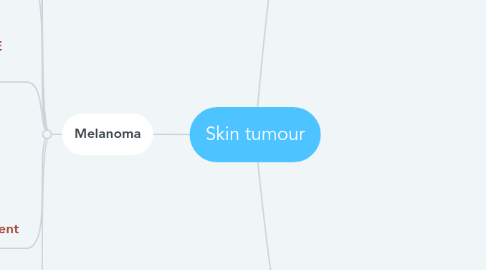
1. Melanoma
1.1. cancer of melanocytes.
1.2. arises in skin.
1.3. Can form anywhere that melanocytes exist, such as in the bowel mucosa, the retina and the leptomeninges.
1.4. Rising incidence
1.5. Caused by UV exposure
1.6. Superficial spreading form is the most common
1.7. STAGING OF MELANOMA (STAGE BRESLOW’S DEPTH)
1.7.1. I
1.7.1.1. less or equal to 0.75mm
1.7.2. II
1.7.2.1. 0.76 mm - 1.50mm
1.7.3. III
1.7.3.1. 1.51 mm - 2.25mm
1.7.4. IV
1.7.4.1. 2.26 mm - 3.0mm
1.7.5. V
1.7.5.1. greater than 3.0 mm
1.8. Management
1.8.1. History and clinical examination
1.8.2. Identifying local, regional or distant spread.
1.8.3. An Excision biopsy with a 2-mm margin of skin and a cuff of subdermal fat is acceptable in the first instance.
1.8.4. Biopsy and pathological examination provide the first step towards staging melanoma.
1.8.4.1. The Breslow thickness of a melanoma
1.8.5. is the most important prognostic indicator in the absence of lymph node metastases.
1.8.5.1. (measured to nearest 0.1 mm from the granular layer to the base of the tumour)
1.9. Local treatment
1.9.1. The treatment for Melanoma is surgery.
1.9.2. should be excised completely .
1.9.3. A complete excision with a clinical 5-mm margin requires no further treatment.
1.9.4. For melanoma < 1 mm deep, wide local excision with a 1- cm margin is sufficient.
1.9.5. For deeper lesions, a 2-cm margin is recommended.
1.9.6. Regional lymph nodes
1.9.6.1. The likelihood of metastatic spread to regional lymph nodes is proportional to the Breslow thickness of the melanoma.
1.9.6.2. therapeutic lymphadenectomy only if regional metastases became clinically evident.
2. BASAL CELL CARCINOMA (RODENT ULCER )
2.1. Common slow growing malignant epidermal tumour
2.2. Rarely metastasize can spread locally.
2.3. Epidemiology
2.3.1. Most common skin tumour
2.3.2. 90%occurs on the face
2.3.2.1. above the line joining angle of mouth to external auditory meatus
2.3.3. Common around eye,nasolabial folds and hairline of scalp
2.3.4. Twice as likely in males as in females
2.4. Aetiology
2.4.1. Sunlight
2.4.2. X-rays
2.4.3. Immunosuppressed patients
2.4.4. Basal cell nevus syndrome
2.4.5. Xeroderma pigmentosum
2.5. Pathology
2.5.1. Raised rolled edges
2.5.2. Pearly nodules with visible fine vesseles
2.5.3. Central ulceration
2.6. Spread of BCC
2.6.1. Slow growing tumour
2.6.2. Local infiltration
2.6.3. Destruction of surrounding tissues including skull,face ,nose and eyes.so called???
2.6.3.1. Called rodent ulcer
2.6.4. Lymphatic and blood spread rarely
2.7. Treatment
2.7.1. (Surgical)
2.7.1.1. Excision biopsy
2.7.1.1.1. carrying a margin clearance of at least 1 cm
2.7.2. non surgical
2.7.2.1. Radiotherapy
2.7.2.2. Local chemotherapy with 5 flourouracil ,imiquimod Gel
2.7.3. Prognosis is good
3. SQUAMOUS CELL CARCINOMA
3.1. Common ((invasive))malignant epidermal tumour
3.2. low but significant potential for metastasis
3.3. EPIDEMIOLOGY
3.3.1. Elderly male
3.3.2. Sun exposed area like face and back of hand
3.3.3. Male more than women
3.4. AETIOLOGY(Predisposing factors)
3.4.1. Exposure to sunshine
3.4.2. Irradiation
3.4.3. Immunosuppressive drugs
3.4.4. Chronic ulceration
3.4.5. Marjolin ulcer
3.4.5.1. malignant change in long standing scar,ulcer or sinus
3.4.5.2. Slow growing,painless,spread to lymphatics
3.4.5.3. Edge is not always raised and everted
3.4.5.4. Can have unusual nodules
3.4.5.5. Should be biopsied early
3.4.5.6. Common with old burn wound
3.5. PATHOLOGY
3.5.1. Macroscopic
3.5.1.1. Typical carcinomatous ulcer with raised everted edges and central scab
3.5.2. Microscopic
3.5.2.1. Solid columns of epithelial cells growing into dermis with epithelial pearls of central keratin surrounded by prickle cells
3.6. SPREAD OF SCC
3.6.1. Local infiltration and ((lymphatics))
3.6.2. Rarely haematological
3.7. CLINICAL PRESENTATION
3.7.1. Hyperkeratotic lesion and crusty on sun damaged skin (pinna)
3.7.2. Ulceration if on lips and genitals
3.8. TREATMENT
3.8.1. Surgical excision
3.8.2. Surgical block dissection of ((Lymph nodes))
3.8.3. Radiotherapy
